Natural Stone Designs Boosts Profits with a BACA Robo Sawjet
Joel Davis
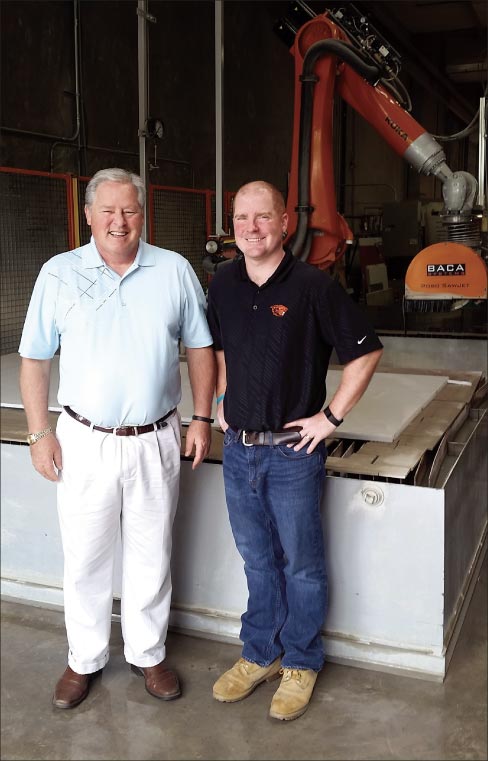 |
|
Above: Left to right: Michael Twiss, Owner of Natural Stone Designs, and Jeremy Twiss, General Manager. Behind them is their BACA Robo SawJet, which has revolutionized production in their shop. |
 |
|
Above: The BACA Robo SawJet makes fast work of dimensioning stone and cutting sinks and curves – all on one machine. This is a fantastic time-saver when fabricating multiple units for commercial projects. |
Natural Stone Designs Inc. has turned a production bottleneck into a floodgate using the BACA Robo SawJet.
Founded in 1991, Natural Stone Designs has one of the largest fabrication shops on the West Coast. The company is based in Tualatin, Oregon, a suburb of Portland.
The company specializes in producing custom marble, granite, and quartz slab stonework for commercial projects. This can range from countertops, reception desks, transaction tops, food service areas, to other custom items.
The Robo SawJet has blown the roof off of production in the Natural Stone Designs shop. “On a traditional saw, we were cutting maybe two to four slabs a day,” owner Mike Twiss said. “On a Robo SawJet, we can cut 10 to 12 slabs a day. It was a pretty easy payback for the machine because we’re cutting almost three times as much.”
The dual table Robo SawJet system integrates both a high-pressure abrasive waterjet and 20 horsepower direct-drive saw. BACA Systems, the manufacturer, estimates using it can save customers 70 percent on labor and 20 percent on materials. It allows fabricators to cut a slab on one table while the other table is being unloaded. It can produce a slab every 20 minutes.
The decision to buy a Robo SawJet came after much research. Twiss was looking to pursue a new market. “We’re a high-end shop, but we only do about 25 percent of what I’d call pure residential, which is Mr. and Mrs. Smith come in and want their countertops done,” he said. “Our company is geared toward commercial contracts in town.”
In the world of commercial contracts, it’s better to go bigger. This wasn’t as feasible with the shop’s capabilities at the time, Twiss said.
“We had started to push into a little bit more of the multi-unit apartments and condos. Lots of units to do, lots of cutting. We were trying to enter a market of under-100 units so we could do them here (in our shop).”
Using a traditional waterjet for the fabrication posed logistical problems. “Waterjets are really good for cutting intricate stuff,” Twiss said. “It’s not very cost-effective to cut straight lines with them.”
This meant using a bridge saw, too. Using both separately meant touching the product twice. This made fabrication too slow. “The bottleneck was that it took too long to cut with the waterjet itself,” he said. “We weren’t able to get to the kind of numbers we wanted with those two pieces of equipment.”
Twiss set out to change this. “In my research, I found out some information about robot saws,” he said. “I visited a company in northern California that had one of the first varieties of them and found out quite quickly that they had three bridge saws sitting in their shop they were no longer using.”
He had a chance to see a previous iteration of the Robo SawJet in action. He was impressed. Twiss said there are people in the industry who are anti-robot, who allege that “They aren’t accurate enough, they can’t do this, they can’t do that.”
This is an outlook that Twiss finds strange. “We can manufacture cars and airplanes that have infinitesimal tolerance allowances with robots but we don’t think a robot can cut a piece of stone accurately enough,” he said. “It didn’t make sense to me. We did some research and found that they cut just fine. We looked at the cost and did the math. It was a natural transition for us to get rid of our waterjet.”
 |
|
Robo Sawjet Photos (2) provided courtesy BACA Systems |
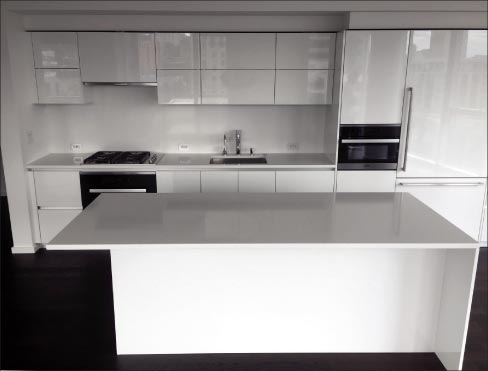 |
|
Above: One of Natural Stone Design’s current projects is the Cosmopolitan highrise, located in downtown Portland, Oregon. It has 150 units, all custom.These two kitchens and the vanity at right feature intricate miter cuts in Pental Super White quartz. |
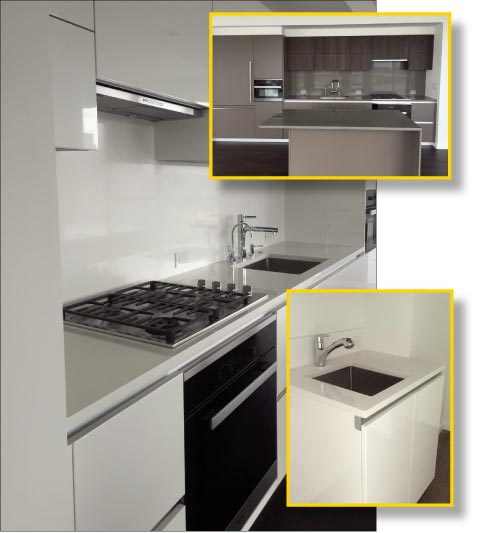 |
|
Above: Other units in this upscale, new highrise feature 3cm Pental Stormy Sky quartz with 2cm full height backsplashes. The units on the upper levels will have other countertop choices available, and are still under construction. |
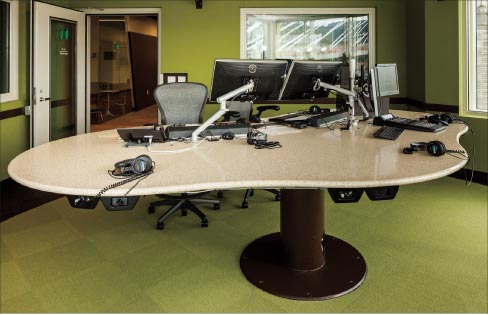 |
|
Three projects showcase the curve-cutting capability of the Robo Sawjet. Above: Rotating, hydraulic DJ table for a radio station in Portland used three full slabs of DuPont Zodiaq Coriander quartz. Project Photos (3) provided courtesy Natural Stone Designs |
Robo SawJet has other advantages. “The maintenance is significantly less than on a traditional stone cutting machine,” he said. “On a traditional machine, you’re always maintaining it. Where this is kind of a self-contained unit and doesn’t take a lot.”
The Robo SawJet uses cutting technology from WaterJet Holdings, which is now known as Shape Technologies Group. It uses an IDE Diamond Cutting Head. The foundry-grade KUKA Robot is waterproof and dustproof. There is no daily or even yearly maintenance required. KUKA is a German manufacturer of industrial robots and solutions for factory automation.
Natural Stone Designs continues to look at ways to improve workflow through the latest technology. “We have always been technology-driven,” Twiss said. “We had one of the first CNCs from Park Industries a million years ago. We’ve still got a CNC now, but we don’t use it because the market has changed. We don’t do a lot of fancy edging. Those workstation kind of machines don’t really fit our model.”
The ability to produce high volume ties into Twiss’ business vision. It’s all about being competitive, he said. “The other thing that has happened in the stone industry, there are tons and tons and tons of little shops,” he said. “In 1991, there were six here in Portland. Now there are more than 100 shops. The only way we could distinguish ourselves was to go after big work. It is a whole lot easier to compete against three or four guys than 20 or 30.”
The BACA Robo SawJet has upended Natural Stone Designs’ traditional logistics. “I can’t cut enough material to keep it working eight hours a day,” Twiss said. “We can process so much stuff so fast the rest of the shop can’t keep up.”
Natural Stone Designs fabricates about $300,000-$400,000 worth of slabs a month. “Our goal is to cut 2,000 slabs a year, 10 slabs a day in 200 days, but it really fluctuates,” he said.
It’s not just quick. The tool provides quality. “It’s absolutely very good quality, and the nice part is you can do everything on one machine,” Twiss said. “I can cut backsplashes, I can cut out sinks, I can cut curves.”
The direct-drive saw cuts all of the straight lines on a slab. The high-pressure abrasive waterjet cuts all of the curves. This brings another benefit. It reduces the cost of materials. “It cuts down on waste,” Twiss said. “On a traditional bridge saw if you have to make a cut, sometimes you have to cut through the end of a slab to get to it.”
The Robo SawJet doesn’t have that problem. “The saw will stop and the waterjet will finish it, so you can’t have what I refer to as over-cuts, which you have to do with a traditional bridge saw,” he said. “We’re saving material. It’s just more efficient.”
The fabrication shop is sister company to Columbia Stone, Inc. This is a specialty subcontractor, owned by Twiss, that designs, fabricates and installs natural stone and terracotta cladding systems. Its projects includes office buildings, museums, courthouses and hospitals.
Natural Stone Designs sometimes provides fabrication services for Columbia Stone. “It does on more of a limited basis,” Twiss said. “Most of the jobs that Columbia Stone does are quite, quite large. We engineer the drawings. We fabricate them overseas.”
Twiss is President / CEO of both companies. He has served as a past president of the Marble Institute of America (2012). He holds a bachelor’s degree in construction management from Oregon State University.
Twiss is also a licensed
civil engineer in California and Washington. Currently, Natural Stone Designs is helping Columbia Stone fulfill a high-profile job. “We’ve got a big job that we’re doing at the Apple headquarters in Cupertino, California,” Twiss said. “We have to customize some very thick pieces.”
Natural Stone Designs is accredited by the Marble Institute of America. The company imports stone from all over the world and maintains an extensive inventory.
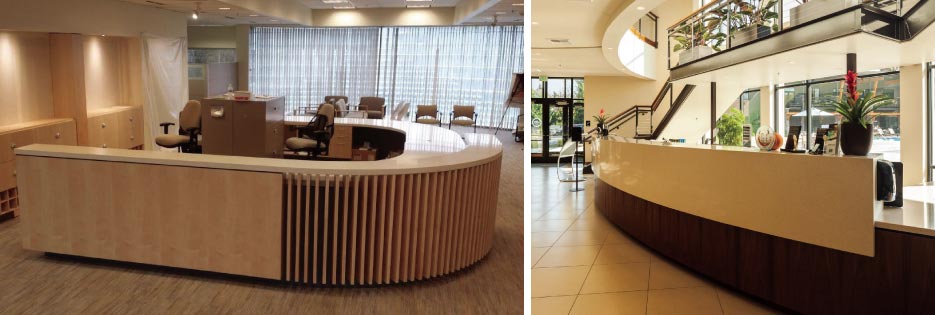 |
|
Above, left: Reception Desk for AAA Club headquarters in Beaverton, Oregon: Pental quartz in Oyster. Above, right: Reception desk at the Stafford Hills Club in Tualatin, Oregon. This gracefully curving seamless surface is fabricated from several slabs of Daltile One Woven Wool quartz. |
Now that Natural Stone Designs has experience with the Robo SawJet, Twiss wants to revamp its whole workflow. “We’ve completely flipped our shop,” he said. “It allows us to put more work through. So now we can overload the shop with cutting. We can cut 10 to 12 slabs a day, and they can’t keep up. Now we’re in the process, we’re starting to analyze the rest of our shop so we can mirror image the production so it’s smooth all the way through and limit the backlog on the back half of the work.”
Natural Stone Designs is using the purchase of the Robo SawJet as a marketing tool. It is a selling point for customers. “This system allows us to speed up our stone fabrication production lines as well as enabling us to make very unique and difficult cuts few other shops can make,” according to the company’s website. “In addition to making very difficult cuts, we also have the ability to properly align natural stone veins between cuts so that the seams between slabs have a continuous pattern that is very hard to detect.”
The reliability and speed of the Robo SawJet is just a foretaste of future technology. “It’s proof positive that this is where the industry is going,” Twiss said. “We’re just going to see more and more of it. I look at the possibilities of what those machines can do, it’s almost limitless. They are all going to continue to improve and become better and better all the time.”
For more information visit the Natural Stone Designs website www.naturalstonedesignsinc.com.